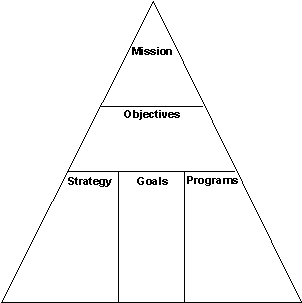
The following plan for strategic management in a youth group context is taken from a book on management. Chapter 5 in the book, by William R. King and David I. Cleland, is entitled: The Choice Elements of Strategic Management. A model is presented that suggests that in strategic management there are a number of choices to be made. The following diagram shows the choice elements of a corporate strategy:

The five elements are: (1) Mission: this is the business that the organisation is in - it includes the nature of the product and the market; (2) Objectives: the desired future position of the organisation; (3) Strategy: the direction in which the objectives will be pursued; (4) Goals: the targets to be reached at specific points in time; and (5) Programs: the events or activities that implement the strategy and pursues the goals.
Using the Windsor youth group as an example the following specific details could be attached to each of these five choice elements of the strategic management plan:
1. Mission
The youth group exists to: reach and disciple youth in Christ who will impact their community and minister in the local church.
2. Objectives
The youth group will aim for the following future positions:
A. Relationships with unchurched youth
B. Conversion of seeking youth
C. Maturity of believers
D. Ministry by believers
3. Strategy
The youth group will take the following directions to pursue the objectives:
A. Reach out into the community to make contact with unchurched youth
B. Evangelise youth who attend evangelistic events
C. Ground converts in the basics of Christianity
D. Develop believers into a growing relationship with Christ
E. Provide service-orientated activities to help youth serve Christ
F. Help youth to identify and use their spiritual gifts
4. Goals
The youth group will aim for the following targets:
A. Make contact with unchurched youth through events in the community
B. Building relationships with unchurched youth at events in the community
C. Invite youth to evangelistic events where they can hear the gospel
D. Follow up new converts through one-on-one mentoring or mentoring communities
E. Grow new converts into mature believers through cell group ministry
F. Challenge believers to serve others through structured service projects
G. Help believers discover their spiritual gifts through gifts workshops
H. Encourage believers to use their spiritual gifts in the youth group and church
5. Programs
The youth group has the following events to implement the strategy and reach the goals:
A. Contact Events - including detached youthwork; concerts and sports
B. Connect Events - weekly events to evangelise seekers.
C. Follow-up Events - weekly meetings for new converts
D. Growth Events - weekly cell group meetings and church services
E. Impact Events - periodic service projects
F. Ministry Events - gift workshops; ministry in cell groups; leadership team involvement
Return to Model of Youth Ministry